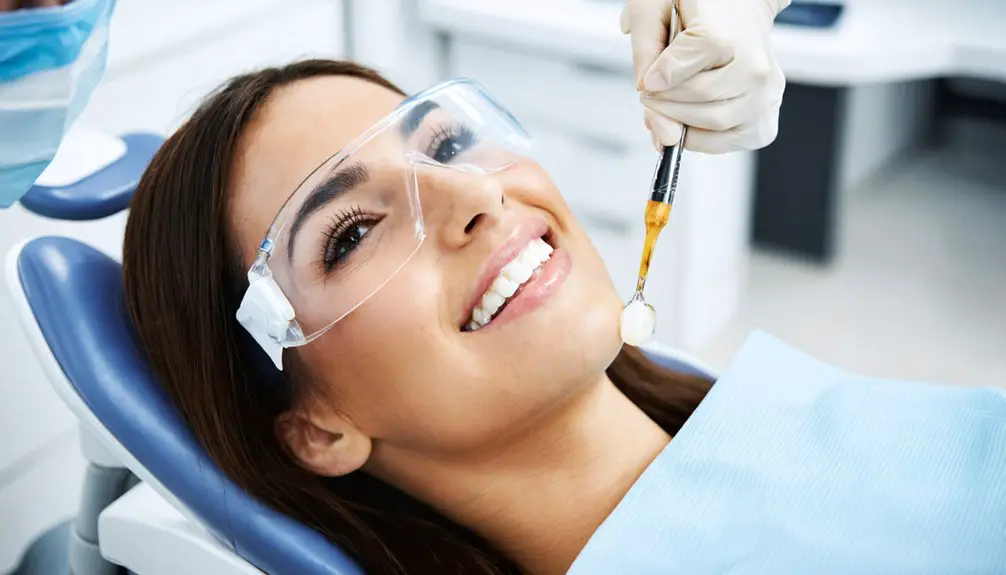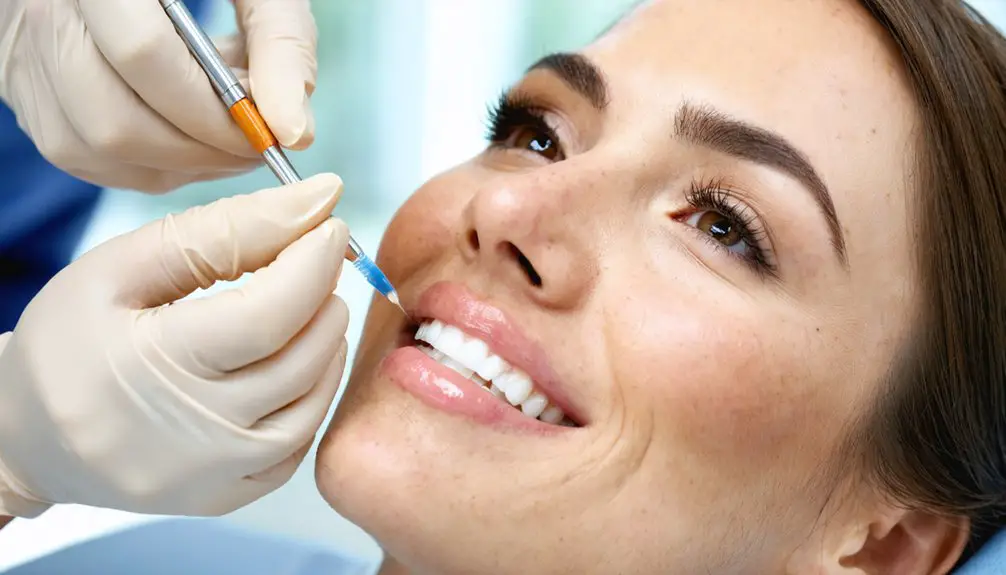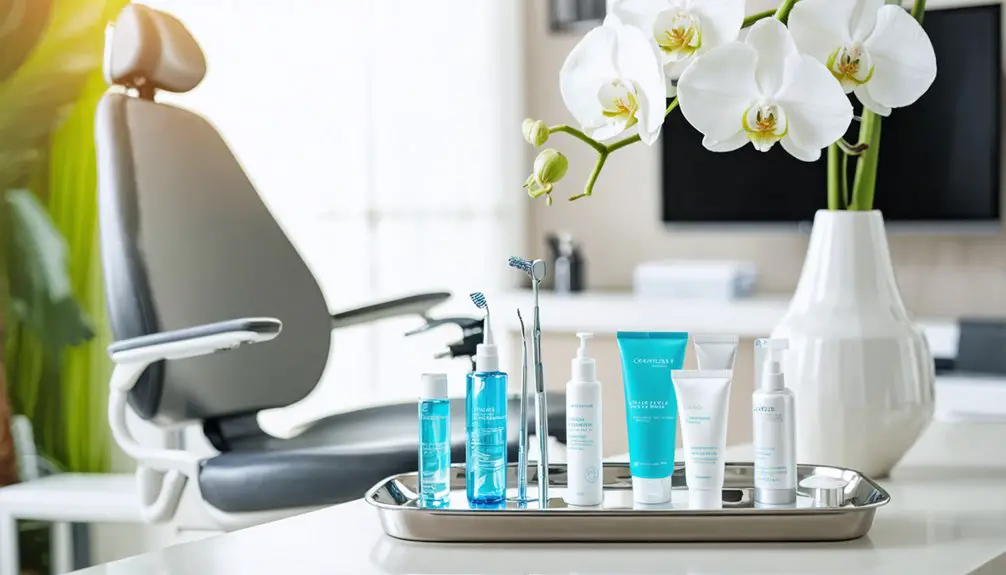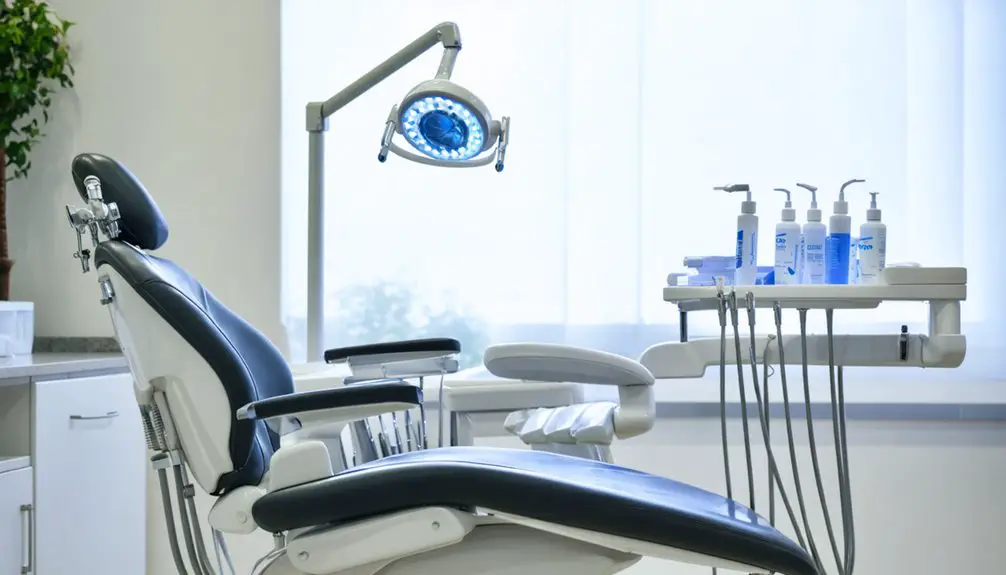Professional teeth whitening can be gentle on sensitive teeth through specialized low-concentration solutions and advanced technology. You’ll find options like custom-fitted trays with 10% hydrogen peroxide for at-home use or LED/laser treatments that minimize discomfort while achieving 6-8 shades of improvement. Pre-treatment with desensitizing toothpaste and proper consultation will help protect your smile. Learn how modern whitening techniques can safely transform your teeth without compromising comfort.
Key Takeaways
- Custom-fitted trays with low-concentration peroxide (10%) provide gentle whitening while minimizing sensitivity through precise application and optimal contact.
- Pre-treatment with desensitizing toothpaste containing potassium nitrate for two weeks reduces discomfort during whitening procedures.
- LED technology offers gentle whitening by activating specialized gels at lower temperatures, achieving 6-8 shades improvement in 10-30 minutes.
- Professional solutions like LaserGlow incorporate protective ingredients such as potassium nitrate and fluoride while effectively whitening teeth.
- Gradual whitening processes begin with dental assessment and use lower concentrations of peroxide for gentle yet consistent results.
Understanding Tooth Sensitivity and Whitening Options
While tooth sensitivity affects a significant portion of the global population, understanding its causes and relationship to whitening treatments can help you make informed decisions about gentle brightening options.
Tooth sensitivity occurs when dentinal tubules become exposed, transmitting temperature and pressure signals to nerve endings within your teeth. You’ll often notice sharp pain triggered by cold foods or acidic beverages. Immediate sharp pain is triggered by hot, cold, sweet, or citric stimuli. Common causes include gingival recession, enamel erosion, and aggressive brushing habits. Clinical examinations and differential diagnosis are essential to rule out other potential causes of dental pain like pulpitis or fractures.
Exposed dentinal tubules send pain signals to tooth nerves when triggered by temperature changes, often due to worn enamel or receding gums.
Contrary to whitening myths, professional treatments can be safe for sensitive teeth when properly administered.
Women and adults aged 18-44 are more likely to experience sensitivity, with European studies showing prevalence rates over 50%. If you’re experiencing discomfort, it’s important to address underlying causes before pursuing whitening treatments, as about half of sensitivity cases remain untreated despite affecting quality of life.
Professional Low-Concentration Whitening Solutions
When seeking gentler alternatives for sensitive teeth, professional low-concentration whitening solutions offer a scientifically proven approach to brightening your smile.
These professional formulations typically contain 10-30% hydrogen peroxide, with lower concentrations around 10% recommended for take-home treatments. For comparison, professional-grade solutions like LaserGlow contain 44% hydrogen peroxide for maximum whitening power.
The whitening process works by opening the enamel to remove deep stains. The low concentration benefits are significant: you’ll experience gradual whitening results while minimizing sensitivity risks.
These solutions can achieve 8-12 shades of improvement through multiple sessions, incorporating protective ingredients like potassium nitrate and fluoride.
Your dentist will deliver the treatment using custom-fitted trays or dual-barrel syringes, often with gingival barriers to protect soft tissue.
The controlled application guarantees the whitening gel contacts only your tooth surfaces, maximizing effectiveness while maintaining comfort throughout your treatment journey.
Pre-Treatment Methods to Minimize Discomfort
Before starting on any teeth whitening treatment, implementing proper pre-treatment methods can greatly reduce your sensitivity discomfort. Start by using desensitizing toothpaste containing potassium nitrate for at least two weeks before your procedure, as this helps block dentin tubules and calm dental nerves. Custom-fitted trays ensure optimal contact between whitening agents and teeth while protecting sensitive areas.
Regular fluoride application through specialized toothpaste and rinses will strengthen your enamel, making it more resistant to whitening agents. Working with your dentist to select a lower peroxide level gel can provide effective whitening while minimizing tooth sensitivity.
Schedule a dental assessment to identify and address any existing issues like decay or erosion that could increase sensitivity. Your dentist may recommend professional fluoride varnish treatment or custom-fitted trays to guarantee even gel distribution.
Maintain excellent oral hygiene with ultra-soft toothbrushes and gentle brushing techniques to prepare your teeth and gums for the whitening process.
Step-by-Step Gradual Whitening Process
Your whitening journey begins with a thorough dental assessment to evaluate tooth sensitivity, existing restorations, and the type of staining you’re experiencing.
The dentist carefully examines your teeth since yellow stains tend to respond best to whitening treatments.
You’ll receive custom-fitted trays that are precisely molded to your teeth’s shape, ensuring ideal contact between the whitening gel and tooth surfaces.
The dentist will carefully select a lower-concentration peroxide gel that’s gentle on sensitive teeth while still delivering effective results. Professional guidance ensures you achieve safe and consistent whitening results throughout the process.
Initial Treatment Assessment Process
To guarantee the safest and most effective whitening treatment for sensitive teeth, a thorough initial assessment begins with a detailed shade analysis using standardized color charts.
Your dental professional will evaluate your tooth sensitivity levels and overall oral health to determine treatment suitability. They’ll inspect for existing dental work, plaque buildup, and any enamel irregularities that could affect your results.
During this assessment, you’ll discuss your lifestyle factors, including diet choices, smoking habits, and medications that might influence tooth staining or sensitivity.
Your provider will carefully consider your desired outcome while setting realistic expectations for your treatment plan. A professional cleaning is necessary before whitening to ensure optimal penetration of the bleaching agents.
This extensive evaluation guarantees you’ll receive a customized whitening approach that prioritizes your comfort and safety while working towards your smile goals.
Using a shade guide, your dentist will document your natural tooth color to track progress throughout the whitening process.
Custom Tray Fitting Steps
Once your assessment confirms you’re ready for whitening treatment, the custom tray fitting process begins with precise dental impressions or 3D scans of your teeth.
These detailed fitting measurements guarantee your whitening trays will provide ideal coverage and comfort. Dental professionals craft your custom trays using clear, flexible custom tray materials designed specifically for tooth whitening procedures.
- Physical models are created from your impressions using durable materials to serve as exact blueprints
- Each tray is carefully molded to match your unique tooth contours while avoiding gum tissue
- Fabrication typically takes between 30 minutes to 24 hours depending on the method used
- Final adjustments guarantee a snug, comfortable fit that will effectively hold whitening gel against tooth surfaces
Advanced Technology for Comfortable Results

Modern LED and laser systems offer you gentle yet effective whitening solutions by precisely activating specialized peroxide gels at lower concentrations.
You’ll benefit from LED technology’s cool blue light that minimizes heat and irritation while achieving noticeable results, or laser treatments that can brighten your teeth up to 10 shades in a single session.
These advanced systems, combined with low-intensity peroxide formulations, enable your dentist to customize treatments that protect sensitive teeth while delivering the bright smile you desire.
LED Light Systems Benefits
While traditional teeth whitening methods have relied on basic chemical agents, LED light systems represent a significant advancement in gentle whitening technology.
The enhanced LED efficacy comes from specific wavelengths that activate whitening gels more effectively, leading to faster and more comfortable results. You’ll experience superior whitening safety since LED systems generate minimal heat and avoid the risks associated with UV exposure.
Key benefits of LED whitening systems include:
- Achieves 6-8 shades brighter in just 10-30 minutes
- Reduces sensitivity through precise control of light intensity
- Prevents tissue damage with non-ionizing, cooler light technology
- Provides immediate visible results with longer-lasting outcomes
This advanced technology is particularly suitable if you have sensitive teeth, offering controlled, gentle treatment while still delivering professional-grade whitening results.
Laser Treatment Advantages
Laser teeth whitening technology brings a new level of sophistication to gentle dental care.
Through laser precision, your dentist can target specific stains and discolorations with remarkable accuracy, ensuring even results while protecting surrounding gum tissue. Treatment customization allows for adjusting laser intensity based on your unique needs and sensitivity levels.
You’ll appreciate how this advanced approach delivers noticeable results in just 30-60 minutes, often brightening teeth by up to 8 shades in a single session.
The non-invasive procedure minimizes sensitivity thanks to controlled laser energy and protective barriers. Under professional supervision, you’ll receive safe, predictable outcomes that can last several months to a year.
For those with sensitive teeth seeking effective whitening, laser treatment offers the perfect balance of power and gentleness.
Low-Intensity Peroxide Solutions
For those seeking gentler teeth whitening options, low-intensity peroxide solutions represent a significant breakthrough in comfortable dental care.
These formulations use carefully calibrated concentrations of 3-15% hydrogen peroxide or 10-22% carbamide peroxide to deliver effective results while prioritizing your comfort and safety.
Advanced technology combines pH optimization with protective ingredients to guarantee low intensity effectiveness without compromising your enamel health.
- Water-rich gel bases prevent dehydration and minimize sensitivity during treatment
- Controlled-release formulas provide steady whitening action over extended periods
- Desensitizing agents like potassium nitrate and fluoride protect nerve endings
- Professional supervision guarantees peroxide safety through customized treatment plans
Clinical studies confirm that these gentler solutions can achieve several shades of improvement while maintaining excellent safety profiles, especially when combined with proper home maintenance protocols.
Maintaining Your Bright Smile Without Sensitivity

Successfully maintaining your bright smile doesn’t have to come with ongoing tooth sensitivity. You’ll find long-term comfort by implementing a targeted maintenance routine that protects your whitening results while preventing discomfort.
Start by continuing to use sensitivity toothpaste daily, as it helps block nerve pain and maintains the protective barrier you’ve built.
Identify your sensitivity triggers and avoid foods and beverages that can stain or irritate your teeth. Practice gentle brushing techniques to preserve your enamel, and incorporate a fluoride mouthwash to strengthen tooth structure.
You’ll also want to schedule regular dental check-ups to monitor your enamel health and make adjustments to your whitening protocol as needed.
This thorough approach guarantees you’ll maintain your bright smile while keeping sensitivity at bay.
Frequently Asked Questions
Can I Drink Coffee During My Whitening Treatment Period?
While you’ll need to avoid coffee during treatment, you can manage sensitivity and maintain results by switching to clear coffee alternatives like herbal tea or water for at least 48-72 hours.
How Long Should I Wait After Dental Work Before Starting Whitening Treatments?
You’ll need to follow specific post dental recovery times: 7-14 days for fillings, 2-4 weeks for crowns/bridges, and 3-4 weeks after root canals. Your whitening timeline depends on your procedure type.
Will Whitening Affect Existing Dental Crowns or Veneers?
You won’t see whitening effects on your existing crowns or veneers, as they’re made from non-porous materials. While crown maintenance remains unaffected, the treatment may create color differences with natural teeth.
Can I Use Whitening Products While Pregnant or Breastfeeding?
You’ll want to avoid whitening during pregnancy and breastfeeding as a safety precaution. Consider alternative options like professional cleaning or natural whitening methods until after this important period.
How Soon After a Cleaning Should I Schedule My Whitening Treatment?
You’ll get ideal whitening results by scheduling your treatment immediately after your dental cleaning. Your teeth’s surfaces will be free of debris, allowing whitening agents to work more effectively and uniformly.
References
- https://www.afacd.com/how-whiten-sensitive-teeth/
- https://buforddentist.com/what-are-the-best-whitening-options-for-sensitive-teeth/
- https://www.tualatinvalleydental.com/post/teeth-whitening-for-sensitive-teeth
- https://newimagedentalltd.com/types-of-professional-teeth-whitening/
- https://www.culvercitydentist.com/blogs/teeth-whitening/best-teeth-whitening-options-for-people-with-sensitive-teeth
- https://pmc.ncbi.nlm.nih.gov/articles/PMC3819160/
- https://pmc.ncbi.nlm.nih.gov/articles/PMC11326452/
- https://www.haleon.com/news/press-releases/brand/2023/new-study-reveals-now-1-in-2-adults-are-sufferung-the-pain-of-tooth-sensitivity
- https://professional.sunstargum.com/en-en/news-events/tooth-sensitivity-facts-and-research-for-professionals.html
- https://thelandingdentalspa.com/sensitive-teeth-causes-treatment-and-prevention/



